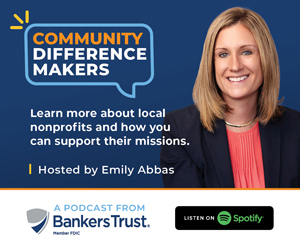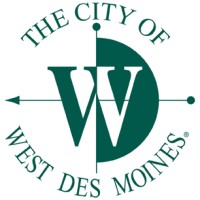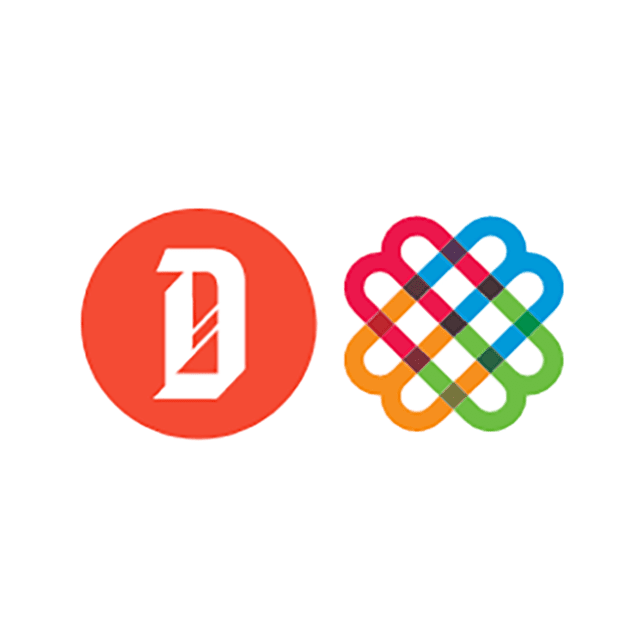Above and beyond group health plans
What’s working well in employee well-being programs?

The Greater Des Moines Botanical Garden is growing more than lush green plants, exotic tropical flowers and restful outdoor tree-lined walkways. The nonprofit organization has also developed a vibrant employee well-being program that, with the assistance of Wellmark Blue Cross and Blue Shield, has blossomed into a thriving program of well-being opportunities for the community at large.
Wellmark’s well-being experts point to the botanical garden’s efforts in cultivating new healthy resources for the community as a useful case study for Central Iowa business and nonprofit leaders, as they look for ways to revitalize their organizations’ culture and employee well-being in a post-pandemic world.
Among Central Iowa employers that Wellmark works with, “we have seen an incredible increase in interest in health and well-being,” said Julie Enga, team leader of Wellmark’s employer consulting and well-being services. “I think prior to COVID, employer groups knew it was important, but it was probably a nice-to-have benefit. Through COVID, and post-COVID, it’s become part of their overall workforce strategy. It’s become a business imperative to make sure your employees are healthy in order for your business to run and be profitable. So we have seen the number of employer groups that we’re meeting with has increased over the last couple of years by 300%.”
In addition to the impact that COVID has had on employers’ ability to offer these programs, organizations face a potential shift in the legal landscape for offering incentives for wellness or well-being programs. New guidance released in June by the Equal Opportunity Employment Commission details how organizations can offer such incentives without violating federal labor laws.
Organizations such as the Greater Des Moines Botanical Garden are finding success in adopting broader well-being programs that go beyond physical wellness to address a range of indicators known as the Six Pillars of Well-Being.
Identifying what types of well-being benefits should be offered is a challenge, which is why the botanical garden worked with Wellmark, said Azure Christensen, chief advancement officer for the Greater Des Moines Botanical Garden.
“Wellmark has been hands-on where we’ve wanted them and needed them and provided resources and ideas to meet our challenges to create something that not only works for our staff, but also for our guests,” Christensen said. “We have a very unique situation, and Wellmark understood that we’re not just beautiful gardens, but [here] to engage and have a bigger impact.”
Cory Jackson, one of Wellmark’s employer health and well-being consultants, worked with the botanical garden staff to implement a plan that incorporated the six pillars — physical, career, financial, social, community and emotional — to build a more complete package. Jackson also worked with the staff to extend those well-being offerings to the public that visits the garden.
A growing body of research
In its case study of the Greater Des Moines Botanical Garden, Wellmark officials acknowledge that a growing body of research is finding that traditional employer-sponsored wellness programs — those tied directly to efforts to change diet and exercise habits — in themselves “had no significant effects on measured health outcomes, such as weight, blood pressure, cholesterol or blood glucose, nor on rates of medical diagnoses or the use of health care services.”
That’s according to research published in June 2020 by a team of University of Illinois researchers, in a study involving about 4,800 university employees on the Urbana campus. The findings were based on 3,300 members of that group receiving financial incentives to join a wellness program called iThrive. That program offered annual on-site biometric screenings, an online health risk assessment and a menu of wellness activities to choose from.
As with other recent studies on wellness programs, the Illinois study found improvements in some self-reported health outcomes, namely more employees reporting having a primary care physician after the two-year period, along with a greater sense of “being healthy.”
Consequently, many wellness programs are now focusing on workers’ well-being, which, in addition to physical health, encompasses emotional resilience, stress management and financial fitness, as Wellmark noted in its case study on the Botanical Garden.
Enga, who leads the team of well-being consultants at Wellmark, is a registered dietitian whose 24-year career with the company began in supporting individual health and well-being programs internally for Wellmark employees. Twelve years ago, she shifted to working with employer groups, and she has been team leader of employer consulting and well-being services at Wellmark the last three years.
“At Wellmark, we know that the health of our members goes beyond just the medical plan,” she said. “It really goes into those six areas of well-being, and so we have committed our time, our energy through our staff, making sure we’re trained and we’re knowledgeable, and we’re here to support our employer groups, our members that way. As you know, we’re local, so our members are our neighbors in our community, so it’s really important to make sure we’re supporting in all areas for our members.”
Understanding goals and objectives
Working with clients to track outcomes is part of the process, said Jackson, the Wellmark consultant whose clients include the Greater Des Moines Botanical Garden.
“As part of our process, we work with each employer group to understand their goals and objectives,” she said.
As an example of tracking results, “we had a large national group that had low preventive exam utilization, and that was their focus,” she said. “We worked with them to set up their wellness program and to be focused on preventive health, and supported it through communication and rewards. We did measure and track that over four years, and 79% of employees who had been through the wellness program had gotten preventive exams, and so that demonstrated success to them.”
As workplaces emerge from the pandemic, many employer groups are focused on improving participation in preventive health screenings, which lagged while COVID infections were surging, Jackson said.
How have employers kept wellness and well-being programs going in a hybrid work environment?
“We’re bringing in a lot of [employer] groups right now to have that conversation, because it is a pain point,” Enga said. “It’s a struggle for large groups — it was easier to communicate when we were all in one place. … So the leaders and coordinators that we’ve worked with are saying, ‘How do we continue to provide this?’ and they realize it’s even more important now.”
Seeking direct feedback from employees is important, she said. “It’s asking that question, ‘How do you prefer we reach out to you?’ ‘How can we help reach your well-being goals when you’re in the office or when you’re at home?’”
Strong leadership certainly leads to better outcomes and greater success for well-being programs over the long term, Enga said.
“It’s really important that the leadership believes they’re doing it because it’s the right thing to do,” she said. “The other day I saw a national poll that showed 74% of leaders saying employee well-being is fundamental to their overall business strategy as well. So I think doing it for the right reason, and realizing that it’s part of their overall business strategy [is most important].
“It’s also making sure that [organizations] are providing awareness and programs at all levels of where employees may be at. Somebody may not be ready to go run a 5K, but they will sit down and pick up a phone and talk to a counselor about the stress in their life.”
The Six Pillars of Well-Being
Physical: When employees physically feel better, they are more likely to perform better at work. Think of adding wellness programs, individual or team-based challenges, or gym reimbursement.
Career: Ensure your employees have the opportunity to use their strengths at work and understand how their job ties in to the organization and goals.
Financial: Nearly 78% of Americans are living paycheck to paycheck. Offering a program to ease debt or help them save can be a great way to ease their minds.
Social: Friendships in the workplace are essential to a happy workplace. Consider team outings or meeting ice-breakers.
Community: 77% of employees believe volunteering is essential to their overall well-being. Supporting volunteerism or offering programs is a great addition for your business.
Emotional: When employees are emotionally grounded, they are happier and more productive. Offer an employee assistance program, or encourage employees to take frequent brain breaks.
Here’s what a couple of Wellmark-supported well-being programs are doing
Greater Des Moines Botanical Garden
Susan Cory, the volunteer manager with the Greater Des Moines Botanical Garden, knows that her volunteers are some of the nonprofit organization’s biggest advocates. That’s why the well-being programs that the garden launched this past fiscal year were the focus of a fall volunteer celebration the organization recently hosted on a Saturday morning, attended by about 35 volunteers.
As part of the morning event, an exercise instructor led the volunteers in stretching, and each volunteer was asked to take the garden’s self-guided wellness tour and to provide feedback on it.
In the fiscal year that ended June 30, the garden hosted more than 300 visitors who took part in well-being activities, which ranged from simple “forest bathing” experiences to the wellness nature walk and other physical activities, such as yoga and Pilates classes. Nearly half of the sessions attended were during the summer sessions, Cory noted. Also, the garden welcomed just over 700 guests for a free-admission wellness day event.
“We really tried to provide a variety of things to appeal to different people,” she said. Among the benefits that visitors have commented on in feedback surveys are reducing tension, finding peace and recouping strength. Also, staff members were provided incentives to participate in the programs through free or discounted access.
The Greater Des Moines Botanical Garden “definitely” plans to continue offering the well-being program in its next fiscal year, as part of the overall “Wild Landscapes” theme focused on helping the community look at how to work with native plants more closely in public and home plantings.
Des Moines Public School District
The Des Moines Public School District has worked with Wellmark on its well-being programs for more than 12 years. Katie Northness has been the well-being coordinator for Des Moines Public Schools since 2017, and the district offers a wide variety of well-being incentives that employees can choose from, she said.
“Holy buckets, it’s easy for me to forget what’s all offered, because there is so much,” she said.
For instance, the district is currently offering an online financial fitness academy. An employee assistance program is also an integral part of the well-being program, and Northness strives to promote about four well-being challenges of different types each year.
By participating in at least one well-being activity each year, district employees can earn up to $600 per year in financial incentives, which if fully earned, completely offset their annual group health insurance premium. Approximately 90% of the 4,400 people eligible for the program participate in at least one activity, Northness said.
An important element of the well-being program that helps drive employee engagement is having a wellness champion in each building that staff can work with to connect with the various activities.
Working with Wellmark, the district can look at the big picture of claims data and knows that its well-being program participants on average are incurring smaller health claims — an average of $1,380 per member, per year less — than those not participating in the program, Northness said. “An important part of this is keeping the healthy people healthy; that’s where we continue to see the savings,” she said.
Northness works in tandem with the district’s recruitment and retention specialist, which is a recognition that retention and well-being are overlapping and reinforce one another, she said.
“Just the biggest change that I’ve seen is that employee well-being is not just ‘get your steps in and get your water,’ it’s about overall well-being.”








